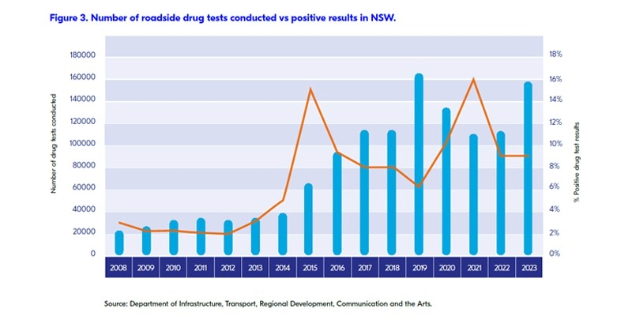Driving high: the need to detect drug drivers

Drug driving is a growing threat on NSW roads, contributing to an average of 74 fatalities annually. Despite roadside drug testing being introduced in 2007, with cocaine added in 2018, almost one in ten drivers tested still show illicit drugs in their system. High visibility policing and robust drug testing are crucial deterrents, yet NSW has not met its target of 200,000 annual tests, with only 160,000 conducted in 2023.
Our Driving high report released today as part of our Road Safety Series highlights these challenges and offers deeper insights into the data, trends, and solutions for tackling drug driving. It also explores the need for comprehensive crash reporting and public education about the risks of both illicit drugs and medications.
Read our full report to understand how we can make drug driving as socially unacceptable as drink driving and save lives on NSW roads.
What the NRMA wants
- Increase in roadside drug testing
- Resourcing for Police to ensure high visibility policing, especially on country roads
- Publicly release roadside drug and alcohol testing enforcement data sooner
- More public education on the effects of drug driving, including medication
Effects of the high
- Drug driving contributes to 24% of road deaths on the NSW roads.
- On average, each year 74 lives are lost due to drug related crashes.
- Over a five year period, 67% of all illicit drug related fatalities occurred on country roads.
- In 2023, 79 people lost their lives in a drug related crashes (up from 55 in 2022).
Tested positive
NSW Police conducted 129,610 roadside dug tests in 2023. Almost 1 in 10 tested positive to illicit drugs.

Failure to hit target
To our knowledge, NSW have set mobile drug testing targets since 2015. The NSW Government committed to tripling the number of roadside drug tests to 97,000 by 2017. This was achieved with over 110,000 tests conducted. In 2018, the NSW Government announced plans to double the number of roadside drug tests from 100,000 annually to 200,000 by 2020. For the past six years, this target has never been met. The closest NSW came to achieving this target was pre-COVID with 166,351 tests conducted in 2019.
In 2023, only 159,610 tests were conducted. With drug driving contributing to 24 per cent of road fatalities, it is crucial that thistarget is met by 2026. Any increase in drug testing should not be at the detriment of the existing Random Breath Testing program.
Release drug testing enforcement data
The NSW Government reports to the Australian Government on the number of roadside drug and alcohol tests they undertake. This data is publicly released each year around late September, once all the data is collated from the other states and territories. Road safety stakeholders and the public are unable to obtain any NSW drug or alcohol enforcement data prior to this release.
Timely data is vital to assess the effectiveness of enforcement measures in addressing the rising road toll. Roadside drug and alcohol testing data should be made publicly available annually, within three months after the end of the calendar year.






